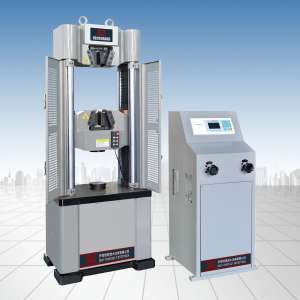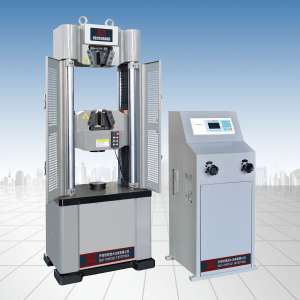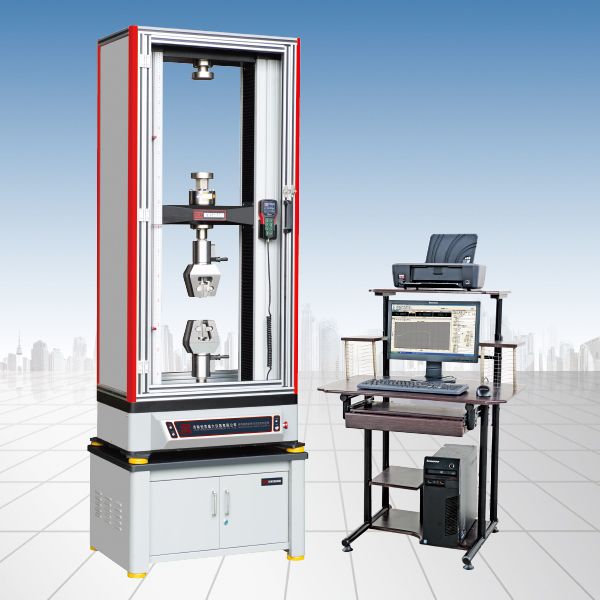Introduction to the working principle of hydraulic universal testing machine, introduction to hydraulic universal testing machine

Introduction to the working principle of hydraulic universal testing machine, introduction to hydraulic universal testing machine

Hydraulic universal testing machine is a hydraulic material testing machine that can perform various tests such as tensile, compression, and bending. Hydraulic universal testing machine is used for tensile, compression, bending and shear tests of various metals and non-metallic materials, as well as special tests of some products. The test operation and data processing comply with the requirements of GB228-2010 "Metal Tensile Test Methods for Room Temperature Materials" and other standards.
1. Loading part
On the base 1 there are two fixed columns 2 and fixed cross beam 3 to form a load-bearing frame.

The working cylinder 4 is fixed to the frame. On the piston 5 of the working cylinder, a movable frame composed of an upper beam 6 , a movable column 7 and a movable platform 8 is supported. When the oil pump 16 is activated, the oil passes through the oil supply valve 17 and enters the working oil cylinder through the oil supply pipe 18, and lifts the piston 5 along with the movable platform 8. In this way, if the specimen is installed between the upper chuck 9 and the lower chuck 12, the upper chuck will rise with the movable platform and the specimen will be stretched. If the specimen is placed between the two pressure-bearing pads 11, or the bent specimen is placed on the two bent supports 10, the movable platform rises due to the stationary beam not moving, and the specimen will be compressed or bent respectively. In addition, if the distance between the upper and lower chucks is to be adjusted before the test begins, the motor 14 can be turned on and the screw 13 can be driven to raise or lower the lower chuck. However, the motor 14 cannot be used to apply tension to the specimen.

2. Force measurement part
During loading, the oil pump motor is turned on, the oil supply valve 17 is opened, and the oil pump sends the oil into the working oil cylinder 4 and pushes the working piston 5 to load the test piece; at the same time, the oil enters the force measurement cylinder 22 through the return oil pipe 19 and the force measurement oil pipe 21 (this is the return oil valve 20 is closed, and the oil cannot flow back to the oil tank 37), and presses the force measurement piston 23, causing it to drive the pull rod 24 to move downward, thereby forcing the swing rod 26 and the pendulum 25 to deflect about the fulcrum point 3 together with the push rod 27. When the push rod is deflected, the toothed rod 28 is pushed horizontally, and the pointer gear of the indices disk 30 is driven to rotate the indices pointer 29 about the center of the indices disk 30 . The angle of rotation of the force indicator is proportional to the total pressure of the force measuring cylinder (ie, the tension force exerted by the tie rod 24). Because the oil pressure in the force measuring cylinder and the working cylinder is the same as 5, the total pressure on the pistons of the two cylinders is proportional (ratio of the piston area). In this way, the angle of the force pointer is proportional to the total pressure on the working cylinder piston, that is, the load on the specimen. After calibration, the needle can be directly only the load on the indicator dial.
Recommended informationNEWS
- [2022-08-04]Tension machine
- [2022-07-29]Staff must conduct necessary inspections on the different structures and parts of the fatigue testing machine
- [2022-07-29]In practical applications, friction between parts is inevitable.
- [2022-07-29]Methods to avoid positioning errors of electronic universal test machines
- [2022-07-29]What errors are prone to occur when using the fatigue test machine
- [2022-07-29]Performance characteristics of electronic universal testing machine and preparations before operation
- [2022-07-20]What are the safety and service life of the woven bag tensile tester?
- [2022-07-20]Several categories of tension machine sensors
- [2022-07-20]Calibration of universal testing machine sensor
- [2022-07-20]Introduction to technical problems of material tensile testing machine
- [2022-07-15]Handling of displacement system failure of tensile test machine
- [2022-07-15]Low temperature impact tester
- [2022-07-15]How to choose a horizontal tensile tester and what to note during experiments
- [2022-07-13]Tips for using universal testing machine
- [2022-07-13]About how to choose a high-precision material testing machine
- [2022-07-08]Impact sample notch hydraulic pulling bed (US standard)
- [2022-07-08]Wide application and precautions for stripping test machines
- [2022-07-08]Common problems and solutions during the use of universal thermal insulation test machine


















